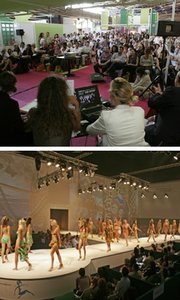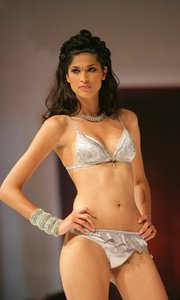'Bra Wars' Provide Backdrop for Lyon, Mode City
LYON, France—European Union and Chinese officials reached terms of an agreement to end the so-called “bra wars” on the closing day of lingerie trade show Lyon, Mode City, held Sept. 3–5 at the Eurexpo convention center.
The agreement, which was approved by the 25 European Union countries on Sept. 7, ends a monthlong dispute, during which more than 75 million bras, T-shirts and other items manufactured in China were held by European Union customs officials after Chinese imports to the European Union exceeded the temporary quotas instituted in June.
Under the agreement, half of the goods will be released with no restrictions and the other half will be deducted from next year’s quota. The goods are expected to be released within a week. The European Union’s temporary quotas, which will remain in place until 2008, were instituted to halt the flood of Chinese goods since the beginning of the year, when quotas for World Trade Organization members ended.
The United States is facing a similar issue but on a much larger scale, as its temporary quotas, or safeguard measures, near capacity.
Forging connections
Europe’s “bra wars” were on the minds of many exhibitors at Lyon, Mode City, although many said they had anticipated the temporary quotas and had made alternate arrangements.
That was the case with first-time exhibitor Peter Burke, president of Irvine, Calif.–based P.J. Salvage. Burke produces his collection of sleepwear, loungewear and lingerie in China, Macau, Turkey, India, Cambodia, Sri Lanka and the Philippines.
“You’ve got to act as if safeguards are already in place,” he said. “We planned for the worst-case scenario: total sanctions.”
Burke, who said he attended the three-day show to expand his distribution overseas, met with distributors and potential customers from Germany, Saudi Arabia, Spain, Holland, France, Italy and Lebanon. In addition, he met with a few U.S. buyers. Burke and his team flew straight from the MAGIC Marketplace in Las Vegas. They brought the same current collection, which included a new group of beach separates.
“We’ve had some really great contacts,” Burke said. “It’s been very exciting to meet distributors.”
Although San Francisco–based lingerie maker Mary Green has been producing its entire collection in China since 1978, the company has not been affected by the temporary quotas in the European Union or in the United States, said Liliana Varbanova, vice president of specialty stores.
“[Quotas] do not concern silks, which is fabulous,” she said. “If it [eventually does] affect us, we would be challenged to look for other resources.”
Varbanova said Mary Green, a new exhibitor at the show, attended the show to expand its market base. Currently, she said, the company has customers in the United Kingdom, Canada, Spain, Greece and Asia thanks to its Web site. “We’d like our presence [overseas] to be stronger,” she noted.
“At the moment, [showing at Lyon, Mode City] makes sense because it gives a chance for the European market to perceive American product,” she added. “It probably takes a few times for a company to be known by the local market.”
The quota situation was more of an issue for the textile representatives showing at Interfiliegrave;re, the lingerie and swimwear fabric show that runs side-by-side with Lyon, Mode City at the Eurexpo.
Albert-Jean Michel, marketing manager for European Stretch Fabrics (ESF), said one of his longtime customers in the United Kingdom had Chinese-made goods on hold and was waiting for the European Union/China resolution.
As ESF awaited payment from its U.K. customer, the company investigated export opportunities for its high-end knits. ESF recently hired an agent in China. “We do some business in China—but it’s a little new for us,” Michel said.
Michel said he saw more international fabric buyers in Lyon, including several from Russia, Poland and Asia.
International draw
Eurexpo expanded the hall holding Lyon, Mode City’s swimwear offerings, which helped improve navigation between the lingerie, swimwear and fabric sections of Lyon, Mode City and Interfiliegrave;re. As a result, some exhibitors said attendance seemed light, although they noted that could be because the event took up more space and there were no longer any bottlenecks between some areas of the shows.
Show organizers could not provide specific attendance information at press time, as they were preparing for their new regional sports apparel and equipment trade show, Sport Achat, bowing Sept. 11–13 at Eurexpo. Organizers did say Lyon, Mode City featured 1,000 brands—including 470 beachwear labels and 530 lingerie brands—from 37 countries. French visitors represented 44 percent of the attendees, other European visitors accounted for 38 percent and visitors from non-European countries made up 18 percent.
Among the retailers shopping at Lyon, Mode City were Paris-based department store Printemps and Seattle-based specialty retailer Nordstrom.
Terri Meichner, senior vice president and general merchandise manager for Fort Meyers, Fla.–based Chico’s FAS Inc., was at the show on the hunt for ideas and materials for the retailer’s new lingerie concept store, Soma by Chico’s. The company has opened 10 Soma stores already and plans to open its 11th at the Fashion Show mall in Las Vegas.
Meichner, a longtime attendee of Lyon, Mode City, noted that she has never spent a Labor Day at home. She said she was looking for market ideas, trends, fabrics and trims for the Soma stores. “I’m even looking at what people are wearing,” she said.
California connection
P.J. Salvage and Mary Green joined a number of California brands exhibiting at the show, including Jonquil; Shirley of Hollywood; Nu-Bra; Speedo; and Juicy Couture Swim, which was represented by its U.K. distributor, 1927.
Marina Prosdocimo, a representative from 1927, explained that the show provided an opportunity to introduce Juicy’s swimwear to an audience that is more familiar with the brand’s sportswear.
“We’re hoping to get the brand well known, [but] we don’t want to sell to everyone; we want to keep it exclusive,” she said.
1927 has distributed Juicy’s sportswear collection in Europe for several years through its agents in France, Italy and Belgium.
For Speedo, the show was an opportunity to show off the company’s fashionable side, said Amy Spenser, who works in the marketing department of Speedo U.K. Speedo France operated the booth, which displayed beach-friendly styles from Speedo by Rosa Chaacute;, the company’s partnership with Brazilian label Rosa Chaacute;.
“We’re pushing the beachwear. We don’t have any of the performance pieces here,” said Spenser, who noted that the French market knows Speedo’s performance line well but is less familiar with the label’s fashion offerings.
“This is very new for the French market,” she said. “We don’t look out of place with the competition in terms of beachwear.”
Shanghai show
Quotas—in the United States or in Europe—were not an issue for longtime Lyon, Mode City exhibitor Jonquil. The fact that the Los Angeles– based lingerie maker produces its entire collection domestically is a strong selling point for many of its customers, according to designer and owner Diane Samandi.
“The majority of our customers are from the Middle East,” she said. “The Middle East customer wants the ’Made in the U.S.A.’ [label].”
Samandi said she was not looking to open new accounts at the show but attended the event because it provides a convenient meeting point for her Middle Eastern customers as well as for her customers from France, Germany and Switzerland.
Show organizers hosted several workshops to help lingerie and swimwear manufacturers investigate overseas markets, including those of the Middle East, Australia, Brazil and China.
Lyon, Mode City’s China workshop was also an opportunity for show organizer Eurovet to introduce its newest venture, Shanghai, Mode Lingerie, set for Oct. 26–28.
The workshop featured advice for manufacturers looking to sell their products in China, including how to tailor merchandise to either the cool northern provinces or the warm southern region. Although mention of the European Union quotas and the “bra wars” drew unhappy murmurs from attendees, the workshop attracted a crowd that filled the conference space and spilled out onto the show floor.
China will likely be at the top of many lingerie and swimwear manufacturers’ agendas in the coming months, particularly in light of the U.S. government’s recent decision to institute temporary quotas on two more categories of Chinese-made goods: synthetic fabrics and bodyshaping garments, including bras.
Nonetheless, apparel and lingerie makers will continue to head east, either with an organized trade show such as Shanghai, Mode Lingerie or independently, as Jonquil’s Samandi will do next month.
The designer said she is planning a trip to Shanghai to source fabrics as well as investigate production opportunities. In the past, Samandi has sourced high-end laces out of China. She said the company recently produced a silk group out of China and was pleased with the result. “In this market, you have to think ahead or you’ll get left behind,” she noted.























